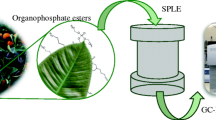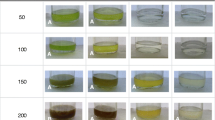Abstract
In this work, an analytical method, based on sonication-assisted extraction, clean-up by dispersive solid-phase extraction and determination by liquid chromatography-tandem mass spectrometry, has been developed and validated for the simultaneous determination of 15 emerging pollutants in leaves from four ornamental tree species. Target compounds include perfluorinated organic compounds, plasticizers, surfactants, brominated flame retardant, and preservatives. The method was optimized using Box-Behnken statistical experimental design with response surface methodology and validated in terms of recovery, accuracy, precision, and method detection and quantification limits. Quantification of target compounds was carried out using matrix-matched calibration curves. The highest recoveries were achieved for the perfluorinated organic compounds (mean values up to 87%) and preservatives (up to 88%). The lowest recoveries were achieved for plasticizers (51%) and brominated flame retardant (63%). Method detection and quantification limits were in the ranges 0.01–0.09 ng/g dry matter (dm) and 0.02–0.30 ng/g dm, respectively, for most of the target compounds. The method was successfully applied to the determination of the target compounds on leaves from four tree species used as urban ornamental trees (Citrus aurantium, Celtis australis, Platanus hispanica, and Jacaranda mimosifolia).

Analytical method for the biomonitorization of emerging pollutants in outdoor air



Similar content being viewed by others
References
Annamalai J, Navasivayam V. Endocrine disrupting chemicals in the atmosphere: their effects on humans and wildlilfe. Environ Int. 2015;76:78–97.
Niu S, Dong L, Zhang L, Zhu C, Hai R, Huang Y. Temporal and spatial distribution, sources, and potential health risks of ambient polycyclic aromatic hydrocarbons in the Yangtze River Delta (YRD) of Eastern China. Chemosphere. 2017;172:72–9.
An H, Zhang G, Liu C, Guo H, Yin W, Xia X. Characterization of PM2.5-bound polycyclic aromatic hydrocarbons and its deposition in Populus tomentosa leaves in Beijing. Environ Sci Pollut Res. 2017;24:8504–15.
Dumanoglu Y, Gaga EO, Gungormus E, Sofuoglu SC, Odabasi M. Spatial and seasonal variations, sources, air-soil exchange, and carcinogenic risk assessment for PAHs and PCBs in air and soil of Kutahya, Turkey, the province of thermal power plants. Sci Total Environ. 2017;580:920–35.
Pucko M, Stern GA, Burt AE, Jantunen LM, Bidleman TF, Macdonald RW, et al. Current use pesticide and legacy organochlorine pesticide dynamics at the ocean-sea ice-atmosphere interface in resolute passage, Canadian Arctic, during winter-summer transition. Sci Total Environ. 2017;580:1460–9.
Anttila P, Brorström-Lundén E, Hansson K, Hakola H, Vestenius M. Assessment of the spatial and temporal distribution of persistent organic pollutants (POPs) in the Nordic atmosphere. Atmos Environ. 2016;140:22–33.
Moreau-Guigon E, Alliot F, Gaspéri J, Blanchard M, Teil MJ, Mandin C, et al. Seasonal fate and gas/particle partitioning of semi-volatile organic compounds in indoor and outdoor air. Atmos Environ. 2016;147:423–33.
Teil MJ, Moreau-Guigon E, Blanchard M, Alliot F, Gasperi J, Cladière M, et al. Endocrine disrupting compounds in gaseous and particulate outdoor air phases according to environmental factors. Chemosphere. 2016;146:94–104.
Kim JY, Lee JY, Kim YP, Lee SB, Jin HC, Bae GN. Seasonal characteristics of the gaseous and particulate PAHs at a roadside station in Seoul. Korea Atmos Res. 2012;116:142–50.
Zhang H, Liu W, He X, Wang Y, Zhang Q. Uptake of Perfluoroalkyl acids in the leaves of coniferous and deciduous broad-leaved trees. Environ Toxicol Chem. 2015;34:1499–504.
Gaspar FW, Castorina R, Maddalena RL, Nishioka MG, McKone TE, Bradman A. Phthalate exposure and risk assessment in California child care facilities. Environ Sci Technol. 2014;48:7593–601.
Drage DS, Newton S, de Wit CA, Harrad S. Concentrations of legacy and emerging flame retardants in air and soil on a transect in the UK West Midlands. Chemosphere. 2016;148:195–203.
Matsumoto H, Adachi S, Suzuki Y. Bisphenol A in ambient air particulates responsable for the proliferation of MCF-7 human breast cancer cells and its concentration changes over 6 months. Arch Environ Contam Toxicol. 2005;48:459–66.
Salgueiro-González N, López de Alda MJ, Muniategui-Lorenzo S, Prada-Rodríguez D, Barceló D. Determination of 13 estrogenic endocrine disrupting compounds in atmospheric particulate matter by pressurised liquid extraction and liquid chromatography-tandem mass spectrometry. Anal Bioanal Chem. 2015;405:8913–23.
Silva JA, Ratola N, Ramos S, Homem V, Santos L, Alves A. An analytical multi-residue approach for the determination of semi-volatile organic pollutants in pine needles. Anal Chim Acta. 2015;858:24–31.
Al Dine EJ, Mokbel H, Elmoll A, Massemin S, Vuilleumier S, Toufally J, et al. Concomitant evaluation of atmospheric levels of polychlorinated biphenyls, organochlorine pesticides, and polycyclic aromatic hydrocarbons in Strasbourg (France) using pine needle passive samplers. Environ Sci Pollut Res. 2015;22:17850–9.
Fasani D, Fermo P, Barroso PJ, Santos JL, Aparicio I, Alonso E. Analytical method for biomonitoring of PAH using leaves of bitter orange trees (Citrus aurantium): a case study in South Spain. Water Air Soil Pollut. 2016;227:360.
Käffer MI, Lemos AT, Apel MA, Rocha JV, Azevedo SM, Ferrao Vargas VM. Use of bioindicators to evaluate air quality and genotoxic compounds in an urban environment in Southern Brazil. Environ Pollut. 2012;163:24–31.
Tarricone K, Wagner G, Klein R. Toward standardization of sample collection and preservation for the quality of results in biomonitoring with trees—a critical review. Ecol Indic. 2015;57:341–59.
Chropeňová M, Karásková P, Kallenborn R, Gregušková EK, Čupr P. Pine needles for the screening of perfluorinated alkylated substances (PFASs) along ski tracks. Environ Sci Technol. 2016;50:9487–96.
Yin H, Tan Q, Chen Y, Lv G, Hou X. Polycyclic aromatic hydrocarbons (PAHs) pollution recorded in annual rings ofgingko(Gingko biloba L.): determination of PAHs by GC/MS after accelerated solvent extraction. Microchem J. 2011;97:138–43.
Rodriguez JH, Wannaz ED, Salazar MJ, Pignata ML, Fangmeier A, Franzaring J. Accumulation of polycyclic aromatic hydrocarbons and heavy metals in the tree foliage of Eucalyptus rostrata, Pinus radiata and Populus hybridus in the vicinity of a large aluminium smelter in Argentina. Atmos Environ. 2012;55:35–42.
Orecchio S. PAHs associated with the leaves of Quercus ilex L.: extraction, GC-MS analysis, distribution and sources assessment of air quality in the Palermo (Italy) area. Atmos Environ. 2007;41:8669–80.
Müller JF, Hawker DW, McLachlan MS, Connell DW. PAHs, PCDD/Fs, PCBs and HCB in leaves from Brisbane, Australia. Chemosphere. 2001;43:507–15.
Sanz-Landaluze J, Bocanegra-Salazar M, Ortiz-Pérez D, Cámara C. Miniaturisated method for the analysis of polycyclic aromatic hydrocarbons in leaf samples. J Chromatogr A. 2010;1217:3567–74.
Ratola N, Lacorte S, Barceló D, Alves A. Microwave-assisted extraction and ultrasonic extraction to determine polycyclic aromatic hydrocarbons in needles and bark of Pinus pinaster Ait. and Pinus pinea L. by GC-MS. Talanta. 2009;77:1120–8.
Ratola N, Alves A, Santos L, Lacorte S. Pine needles as passive bio-samplers to determine polybrominated diphenyl ethers. Chemosphere. 2011;85:247–52.
Naidu R, Arias Espana VA, Liu Y, Jit J. Emerging contaminants in the environment: risk-based analysis for better management. Chemosphere. 2016;154:350–7.
Shan G, Wei M, Zhu L, Liu Z, Zhang Y. Concentration profiles and spatial distribution of perfluoroalkyl substances in an industrial center with condensed fluorochemical facilities. Sci Total Environ. 2014;490:351–9.
Alliot F, Moreau-Guigon E, Bourges C, Desportes A, Teil MJ, Blanchard M, et al. A multi-residue method for characterization of endocrine disruptors in gaseous and particulate phases of ambient air. Atmos Environ. 2014;92:1–8.
Aparicio I, Martín J, Santos JL, Malvar JL, Alonso E. Stir bar sorptive extraction and liquid chromatography–tandem mass spectrometry determination of polar and non-polar emerging and priority pollutants in environmental waters. J Chromatogr A. 2017;1500:43–52.
Mijangos L, Bizkarguenaga E, Prieto A, Fernández LA, Zuloaga O. Simultaneous determination of a variety of endocrine disrupting compounds in carrot, lettuce and amended soil by means of focused ultrasonic solid-liquid extraction and dispersive solid-phase extraction as simplified clean-up strategy. J Chromatogr. 2015;1389:8–18.
Herrmann SS, Poulsen ME. Clean-up of cereal extracts for gas chromatography tandem quadrupole mass spectrometry pesticide residues analysis using primary secondary amine and C18. J Chromatogr A. 2015;1423:47–53.
Rodríguez-González N, González-Castro MJ, Beceiro-González E, Muniategui-Lorenzo S. Development of a matrix solid phase dispersion methodology for the determination of triazine herbicides in mussels. Food Chem. 2015;173:391–6.
Sharif Z, Che Man YB, Hamid NS, Keat CC. Determination of organochlorine and pyrethroid pesticides in fruit and vegetables using SAX/PSA clean-up column. Food Chem. 2007;102:98–103.
Salapasidou M, Samara C, Voutsa D. Endocrine disrupting compounds in the atmosphere of the urban area of Thessaloniki, Greece. Atmos Environ. 2011;45:3720–9.
Author information
Authors and Affiliations
Corresponding author
Ethics declarations
Conflict of interest
The authors declare that they have no competing interest.
Electronic supplementary material
ESM 1
(PDF 373 kb)
Rights and permissions
About this article
Cite this article
Barroso, P.J., Martín, J., Santos, J.L. et al. Analytical method for the evaluation of the outdoor air contamination by emerging pollutants using tree leaves as bioindicators. Anal Bioanal Chem 410, 417–428 (2018). https://doi.org/10.1007/s00216-017-0733-8
Received:
Revised:
Accepted:
Published:
Issue Date:
DOI: https://doi.org/10.1007/s00216-017-0733-8




